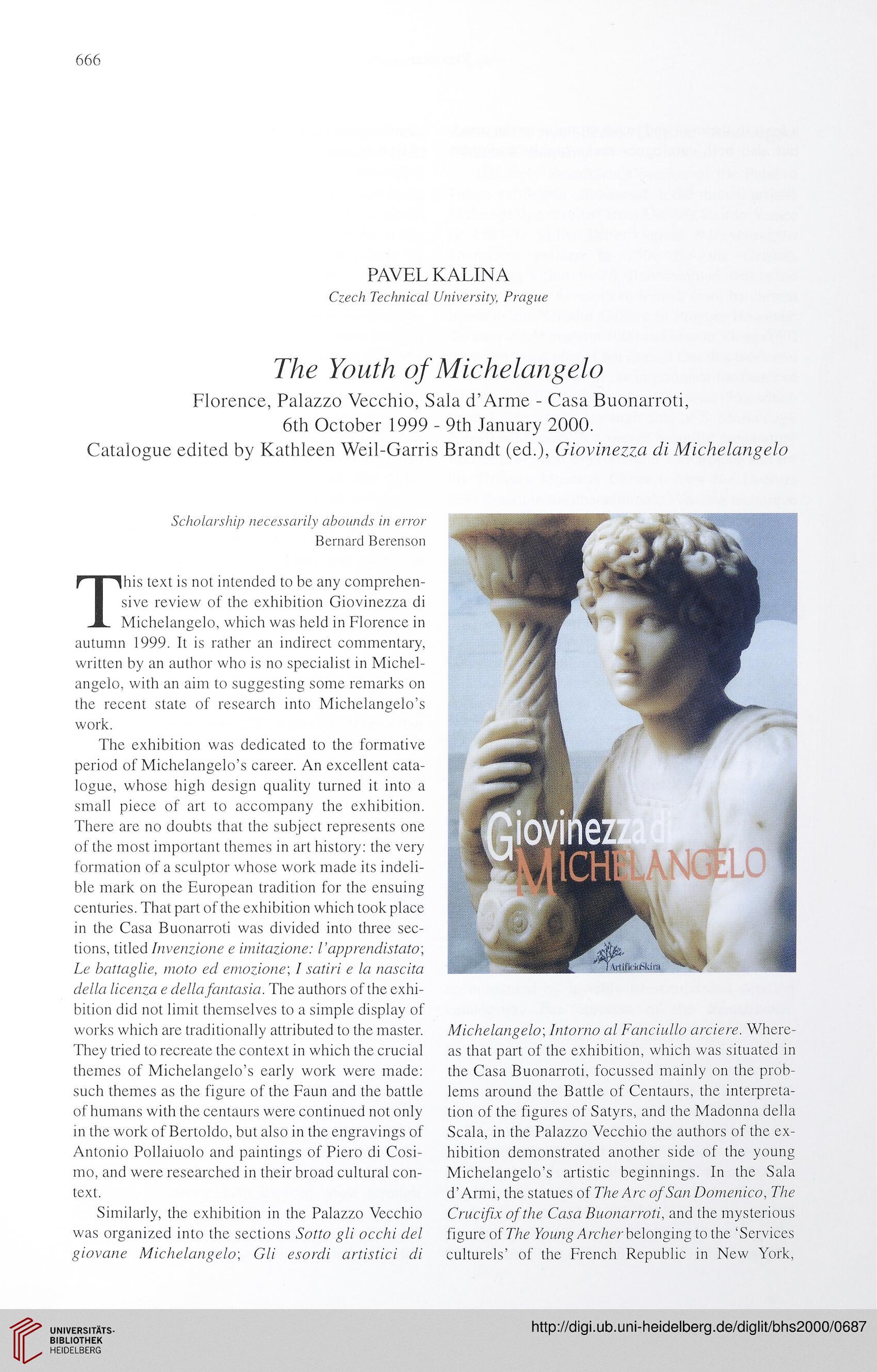666
PAVEL KALINA
Czech Technical Lfniversity, Prague
The Youth of Michelangelo
Florence, Palazzo Vecchio, Sala d’Arme - Casa Buonarroti,
6th October 1999 - 9th January 2000.
Catalogue edited by Kathleen Weil-Garris Brandt (ed.), Giovinezza di Michelangelo
Scholarship necessarily abounds in error
Bernard Berenson
This text is not intended to be any comprehen-
sive review of the exhibition Giovinezza di
Michelangelo, which was held in Florence in
autumn 1999. It is rather an indirect commentary,
written by an author who is no specialist in Michel-
angelo, with an aim to suggesting sonie remarks on
the recent State of research into Michelangelo’s
work.
The exhibition was dedicated to the formative
period of Michelangelo’s career. An excellent cata-
logue, whose high design quality turned it into a
smali piece of art to accompany the exhibition.
There are no doubts that the subject represents one
of the most important themes in art history: the very
formalion of a sculptor whose work madę its indeli-
ble mark on the European tradition for the ensuing
centuries. That part of the exhibition which took place
in the Casa Buonarroti was divided into three sec-
tions, titled Irwenzione e imitazione: V apprendistato',
Le battaglie, nioto ed emozione', I satiri e la nascita
della licenza e dellafantasia. The authors of the exhi-
bition did not limit themselves to a simple display of
works which are traditionally attributed to the master.
They tried to recreate the context in which the crucial
themes of Michelangelo’s early work were madę:
such themes as the figurę of the Faun and the battle
of humans with the centaurs were continued not only
in the work of Bertoldo, but also in the engravings of
Antonio Pollaiuolo and paintings of Piero di Cosi-
mo, and were researched in their broad cultural con-
text.
Similarly, the exhibition in the Palazzo Vecchio
was organized into the sections Sotto gli occhi del
giovane Michelangelo', Gli esordi artistici di
Michelangelo', Intorno al Fanciullo arciere. Where-
as that part of the exhibition, which was situated in
the Casa Buonarroti, focussed mainly on the prob-
lems around the Battle of Centaurs, the interpreta-
tion of the figures of Satyrs, and the Madonna della
Scala, in the Palazzo Yecchio the authors of the ex-
hibition demonstrated another side of the young
Michelangelo’s artistic beginnings. In the Sala
d’ Armi, the statues of The Arc ofSan Domenico, The
Crucifix ofthe Casa Buonarroti, and the mysterious
figurę oiThe Young ArcAerbelonging to the ‘Services
culturels’ of the French Republic in New York,
PAVEL KALINA
Czech Technical Lfniversity, Prague
The Youth of Michelangelo
Florence, Palazzo Vecchio, Sala d’Arme - Casa Buonarroti,
6th October 1999 - 9th January 2000.
Catalogue edited by Kathleen Weil-Garris Brandt (ed.), Giovinezza di Michelangelo
Scholarship necessarily abounds in error
Bernard Berenson
This text is not intended to be any comprehen-
sive review of the exhibition Giovinezza di
Michelangelo, which was held in Florence in
autumn 1999. It is rather an indirect commentary,
written by an author who is no specialist in Michel-
angelo, with an aim to suggesting sonie remarks on
the recent State of research into Michelangelo’s
work.
The exhibition was dedicated to the formative
period of Michelangelo’s career. An excellent cata-
logue, whose high design quality turned it into a
smali piece of art to accompany the exhibition.
There are no doubts that the subject represents one
of the most important themes in art history: the very
formalion of a sculptor whose work madę its indeli-
ble mark on the European tradition for the ensuing
centuries. That part of the exhibition which took place
in the Casa Buonarroti was divided into three sec-
tions, titled Irwenzione e imitazione: V apprendistato',
Le battaglie, nioto ed emozione', I satiri e la nascita
della licenza e dellafantasia. The authors of the exhi-
bition did not limit themselves to a simple display of
works which are traditionally attributed to the master.
They tried to recreate the context in which the crucial
themes of Michelangelo’s early work were madę:
such themes as the figurę of the Faun and the battle
of humans with the centaurs were continued not only
in the work of Bertoldo, but also in the engravings of
Antonio Pollaiuolo and paintings of Piero di Cosi-
mo, and were researched in their broad cultural con-
text.
Similarly, the exhibition in the Palazzo Vecchio
was organized into the sections Sotto gli occhi del
giovane Michelangelo', Gli esordi artistici di
Michelangelo', Intorno al Fanciullo arciere. Where-
as that part of the exhibition, which was situated in
the Casa Buonarroti, focussed mainly on the prob-
lems around the Battle of Centaurs, the interpreta-
tion of the figures of Satyrs, and the Madonna della
Scala, in the Palazzo Yecchio the authors of the ex-
hibition demonstrated another side of the young
Michelangelo’s artistic beginnings. In the Sala
d’ Armi, the statues of The Arc ofSan Domenico, The
Crucifix ofthe Casa Buonarroti, and the mysterious
figurę oiThe Young ArcAerbelonging to the ‘Services
culturels’ of the French Republic in New York,




